American silent film actress Constance Talmadge (1898-1973) was one of the biggest stars of the 1920s, together with her sister Norma. She had her breakthrough in a double role in D.W. Griffith's classic Intolerance (1916). 'Connie' Talmadge appeared in 83 films, mostly romantic comedies, for which Anita Loos wrote several scripts.
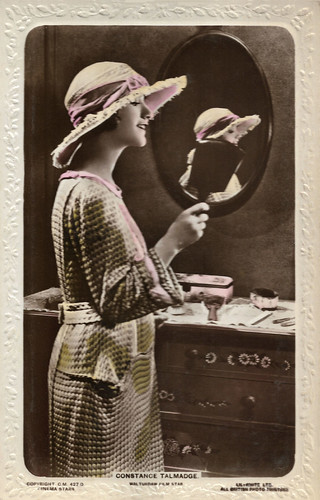
British postcard by Lilywhite in the Cinema Stars series, no. CM 427 D. Photo: Walturdaw.
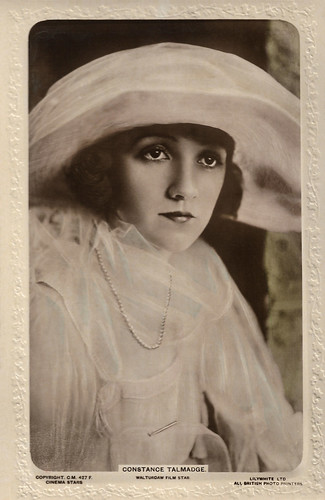
British postcard by Lilywhite in the Cinema Stars series, no. CM 427 F. Photo: Walturdaw.
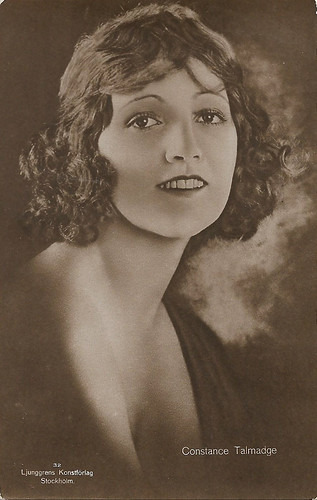
Swedish postcard by Ljunggrens Konstförlag, Stockholm, no. 32.
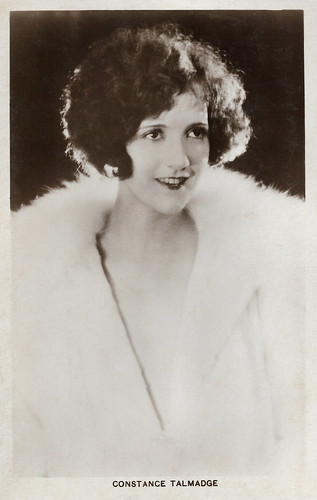
British Real Photograph postcard in the Picturegoer Series, London.
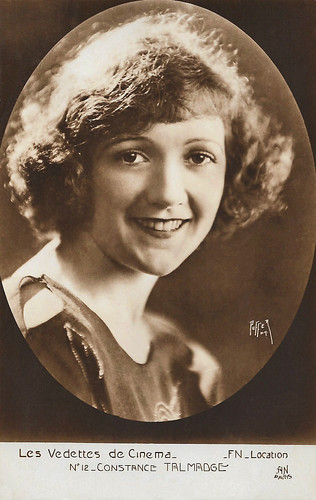
French postcard by A.N., Paris in the Les Vedettes de Cinéma series, no. 12. Photo: B. Frank Puffer / First National Location.
Constance Alice Talmadge was born in Brooklyn, New York, in 1898 (some sources say 1897; and 1903-1973 is engraved on her tomb marker.) Her parents were Fred and Peg Talmadge and her older sisters were the future actresses Norma and Natalie Talmadge. Her father was an alcoholic, and left them when she was still very young. Reportedly, his daughter announced "We're hungry!" to him one Christmas morning when there was no money in the house, and no food in the icebox. "Okay, kiddies, I'll go out and buy some hamburgers," replied Fred, and he walked away from their Brooklyn apartment and never returned.
Peg Talmadge made a living for her family by doing laundry, giving art classes, and selling cosmetics and raised her three daughters alone. Constance was nicknamed 'Dutch' by her mother, because of her adorable blond good looks as a plump little girl. Greta de Groat at Women Film Pioneers Project: "Constance was a tall, gawky blond, not particularly pretty but with a face full of mischief."
When a friend recommended that Constance's mother use other sister Norma as a model for title slides in flickers, which were shown in early nickelodeons, Peg decided to do so. This led the three sisters into an acting career. In 1914, Constance made her film debut at Vitagraph on Avenue W in the Flatbush section of New York in the short silent comedy In Bridal Attire (Lee Beggs, 1914) with comedian Billy Quirk. From her earliest film roles, it was evident that Connie's film forte was going to be comedy, whereas Norma's would be drama.
Her first major part was a double role as the Mountain Girl and as Marguerite de Valois in D.W. Griffith's silent film Intolerance (1916). The three-and-a-half-hour epic was a colossal undertaking featuring monumental sets, lavish period costumes, and more than 3,000 extras. Griffith's masterpiece intercuts four parallel storylines, each separated by several centuries. In the years following its release, Intolerance and its unorthodox editing would strongly influence European film makers.
Talmadge's tomboy character of the Mountain Girl in Intolerance was so popular, that after the release, Griffith filmed her character a new, happy ending instead of a death scene. In 1919 he released the Babylonian episode of Intolerance, as a new, separate film The Fall of Babylon, including the happy end.
Connie had success in the fast productions of the World War I era. Talmadge appeared in many comedies of manners, for which Anita Loos wrote the scripts. Her best known films of the 1910s include A Pair of Silk Stockings (Walter Edwards, 1918) with frequent co-star Harrison Ford, Happiness à la Mode (Walter Edwards, 1919), and Romance and Arabella (Walter Edwards, 1919) with Monte Blue.
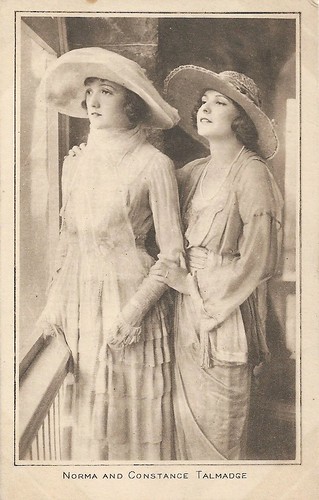
With sister Norma. British postcard in the 'Pictures' Portrait Gallery by Pictures Ltd., London, no. 195.
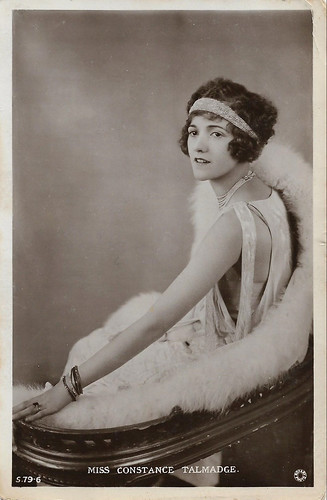
British postcard by Rotary Photo, London, no. S.79-6.
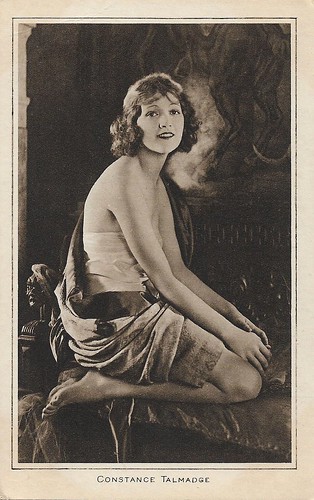
British postcard.
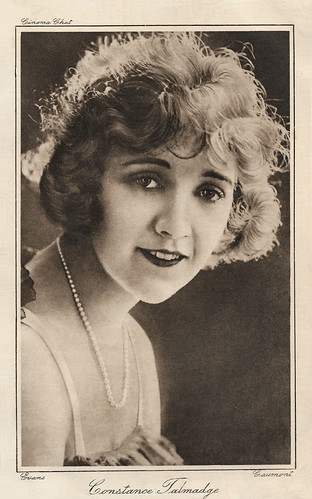
British postcard. Photo: Evans / Gaumont.
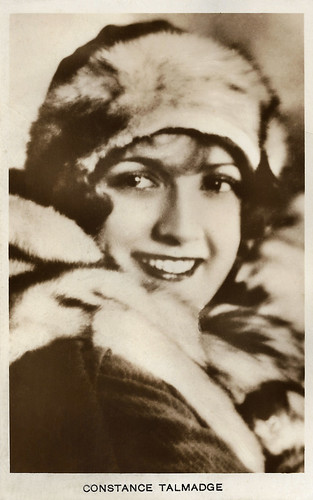
British Real Photograph postcard.
Constance Talmadge shared studios at 318 East 48th Street with her sister Norma. At the time, Norma was married to self-made millionaire and future producer Joseph M. Schenck, who managed both of them. He set up the Norma Talmadge Film Corporation in New York. Constance starred with her frequent co-star Harrison Ford in such films as Wedding Bells (Chester Withey, 1921), and The Primitive Lover (Sidney A. Franklin, 1922).
In a 1921 Moving Picture World poll, brunette Norma and blonde Constance Talmadge were voted the first and second most popular movie actresses in the country. They had sizable foreign followings as well. As both girls' film careers grew in stature, there was never any professional jealousy between the two sisters. They were lifelong friends and supported each other. They moved their operations to what the newspapers called Los Angeles but what soon was better known as Hollywood.
Connie worked for Paramount-Famous Players, and formed her own production company as well. One of her great successes was Her Sister From Paris (Sidney Franklin, 1925), in which a new British actor named Ronald Colman was her leading man. She usually played a wilful young woman who was constantly having misunderstandings with the men in her life.
Her sister Nathalie had married comedian Buster Keaton and Constance had a funny uncredited bit part in her brother-in-law's comedy classic Seven Chances (Buster Keaton, 1925), as the girl driving a car who so distracts Buster that he crashes into a tree with his own car. She was also quite delightfully funny in another surviving comedy, The Duchess of Buffalo (Sidney Franklin, 1926) with Tullio Carminati. With the advent of sound film in 1929, Norma did make a handful of appearances in talking films.
In 1929, Time magazine reported that Constance had become bored with film making. Constance however refused to take the voice test for the new sound medium and made one last silent film in France, Vénus (Louis Mercanton, 1929) with André Roanne and Jean Murat, before retiring from the screen. Her adoring public never got to hear her voice. Gary Brumburgh at IMDb: "The notion that they willingly abandoned their careers while very much on top does not quite ring true. Both she and Norma's pronounced and rather squeaky Brooklyn accent did not prove all that suitable for talkies (particularly for the dramatic Norma) and it's more likely that they left Hollywood on their own terms before they were shunned."
The three sisters retired all together, investing in real estate and other business ventures. In 1927, they had opened the Talmadge Park real estate development in San Diego, California, USA. Now known as the Talmadge district, the development contains streets named for each of the sisters. The district is located about one mile southwest of the San Diego State University campus. Like Norma and Natalie, Talmadge succumbed to substance abuse and alcoholism later in life.
Constance also had many failed affairs and relationships, and four marriages; all the unions were childless. Her first marriage, to John Pialoglou, a Greek tobacco importer, occurred in 1920 at a double wedding with Dorothy Gish and James Rennie; she divorced Pialoglou two years later. She married a Scottish officer, Captain Alastair William Mackintosh (grandfather of author Edward St Aubyn), in February 1926, divorcing him in 1927 on grounds of adultery. Then she married Townsend Netcher, a Chicago merchant, in May 1929, divorcing him in 1931. In 1939 followed her marriage to Walter Michael Giblin, which lasted until his death in 1964.
Along with Mary Pickford, Douglas Fairbanks, and her sister Norma Talmadge, Constance inaugurated the tradition of placing her footprints in concrete in the forecourt of Grauman's Chinese Theatre. To make her panel unique, she walked across it leaving five footprints. Her panel is located directly behind the box office.
Constance Talmadge passed away in 1973 in California Hospital in Los Angeles. She was 73. Connie made 83 films between 1914 and 1929. Only a few of her films survive today. In 1978 writer Anita Loos published a memoir of Constance and Norma entitled The Talmadge Girls. She had written scripts for their film projects for several years in the 1910s and 1920s and was a confidante to Peg and the girls. A much earlier, and rarer, book was written by Peg Talmadge herself, The Talmadge Sisters: Norma, Constance, Natalie - An Intimate Story Of The World's Most Famous Screen Family (1924).
Greta de Groat: "In their own times Constance Talmadge was the lower-profile sister, but today she is more familiar than Norma, and her madcap antics may be seen as a precursor to the screwball comedies of the 1930s."
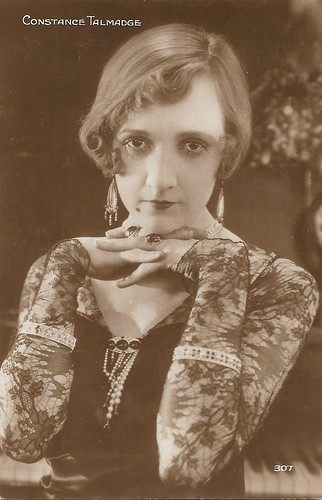
French postcard by Editions Cinémagazine, no. 307.
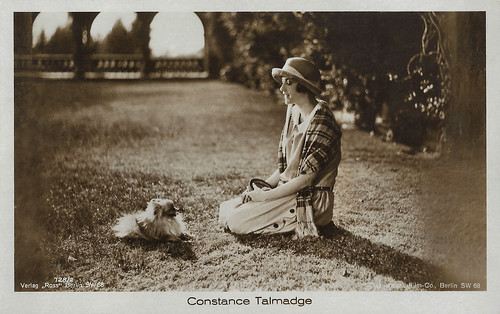
German postcard by Ross Verlag, Berlin, no. 728/2, 1925-1926. Photo: Transocean Film-Co., Berlin.
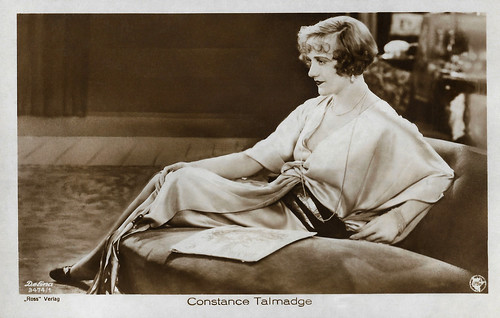
German postcard by Ross Verlag, no. 3474/1, 1927-1928. Photo: Defina / First National.
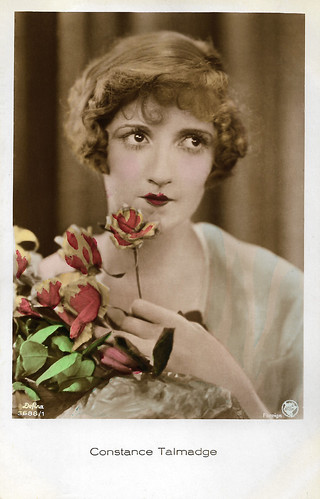
German postcard by Ross Verlag in the Foreign series, no. 3688/1, 1928-1929. Photo: Defina / First National.

German postcard by Ross Verlag, Berlin, no. 4114/1, 1929-1930. Photo: United Artists.

German postcard by Ross Verlag, Berlin, no. 4438/1, 1929-1930. Photo: United Artists. Probably a publicity still for Vénus (Louis Mercanton, 1929).
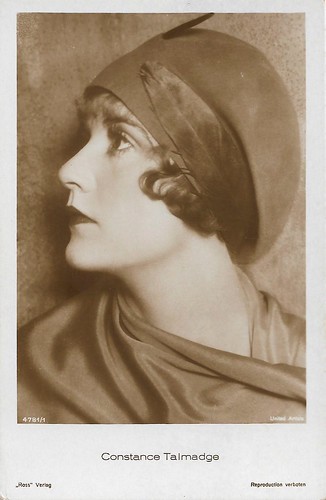
German postcard by Ross Verlag, no. 4781/1, 1929-1930. Photo: United Artists.
Sources: Greta de Groat (Women Film Pioneers Project), Gary Brumburgh (IMDb), The New York Times, Golden Silents, Wikipedia and IMDb.

British postcard by Lilywhite in the Cinema Stars series, no. CM 427 D. Photo: Walturdaw.

British postcard by Lilywhite in the Cinema Stars series, no. CM 427 F. Photo: Walturdaw.

Swedish postcard by Ljunggrens Konstförlag, Stockholm, no. 32.

British Real Photograph postcard in the Picturegoer Series, London.

French postcard by A.N., Paris in the Les Vedettes de Cinéma series, no. 12. Photo: B. Frank Puffer / First National Location.
The Happy ending for a mountain girl
Constance Alice Talmadge was born in Brooklyn, New York, in 1898 (some sources say 1897; and 1903-1973 is engraved on her tomb marker.) Her parents were Fred and Peg Talmadge and her older sisters were the future actresses Norma and Natalie Talmadge. Her father was an alcoholic, and left them when she was still very young. Reportedly, his daughter announced "We're hungry!" to him one Christmas morning when there was no money in the house, and no food in the icebox. "Okay, kiddies, I'll go out and buy some hamburgers," replied Fred, and he walked away from their Brooklyn apartment and never returned.
Peg Talmadge made a living for her family by doing laundry, giving art classes, and selling cosmetics and raised her three daughters alone. Constance was nicknamed 'Dutch' by her mother, because of her adorable blond good looks as a plump little girl. Greta de Groat at Women Film Pioneers Project: "Constance was a tall, gawky blond, not particularly pretty but with a face full of mischief."
When a friend recommended that Constance's mother use other sister Norma as a model for title slides in flickers, which were shown in early nickelodeons, Peg decided to do so. This led the three sisters into an acting career. In 1914, Constance made her film debut at Vitagraph on Avenue W in the Flatbush section of New York in the short silent comedy In Bridal Attire (Lee Beggs, 1914) with comedian Billy Quirk. From her earliest film roles, it was evident that Connie's film forte was going to be comedy, whereas Norma's would be drama.
Her first major part was a double role as the Mountain Girl and as Marguerite de Valois in D.W. Griffith's silent film Intolerance (1916). The three-and-a-half-hour epic was a colossal undertaking featuring monumental sets, lavish period costumes, and more than 3,000 extras. Griffith's masterpiece intercuts four parallel storylines, each separated by several centuries. In the years following its release, Intolerance and its unorthodox editing would strongly influence European film makers.
Talmadge's tomboy character of the Mountain Girl in Intolerance was so popular, that after the release, Griffith filmed her character a new, happy ending instead of a death scene. In 1919 he released the Babylonian episode of Intolerance, as a new, separate film The Fall of Babylon, including the happy end.
Connie had success in the fast productions of the World War I era. Talmadge appeared in many comedies of manners, for which Anita Loos wrote the scripts. Her best known films of the 1910s include A Pair of Silk Stockings (Walter Edwards, 1918) with frequent co-star Harrison Ford, Happiness à la Mode (Walter Edwards, 1919), and Romance and Arabella (Walter Edwards, 1919) with Monte Blue.

With sister Norma. British postcard in the 'Pictures' Portrait Gallery by Pictures Ltd., London, no. 195.

British postcard by Rotary Photo, London, no. S.79-6.

British postcard.

British postcard. Photo: Evans / Gaumont.

British Real Photograph postcard.
Quite delightfully funny
Constance Talmadge shared studios at 318 East 48th Street with her sister Norma. At the time, Norma was married to self-made millionaire and future producer Joseph M. Schenck, who managed both of them. He set up the Norma Talmadge Film Corporation in New York. Constance starred with her frequent co-star Harrison Ford in such films as Wedding Bells (Chester Withey, 1921), and The Primitive Lover (Sidney A. Franklin, 1922).
In a 1921 Moving Picture World poll, brunette Norma and blonde Constance Talmadge were voted the first and second most popular movie actresses in the country. They had sizable foreign followings as well. As both girls' film careers grew in stature, there was never any professional jealousy between the two sisters. They were lifelong friends and supported each other. They moved their operations to what the newspapers called Los Angeles but what soon was better known as Hollywood.
Connie worked for Paramount-Famous Players, and formed her own production company as well. One of her great successes was Her Sister From Paris (Sidney Franklin, 1925), in which a new British actor named Ronald Colman was her leading man. She usually played a wilful young woman who was constantly having misunderstandings with the men in her life.
Her sister Nathalie had married comedian Buster Keaton and Constance had a funny uncredited bit part in her brother-in-law's comedy classic Seven Chances (Buster Keaton, 1925), as the girl driving a car who so distracts Buster that he crashes into a tree with his own car. She was also quite delightfully funny in another surviving comedy, The Duchess of Buffalo (Sidney Franklin, 1926) with Tullio Carminati. With the advent of sound film in 1929, Norma did make a handful of appearances in talking films.
In 1929, Time magazine reported that Constance had become bored with film making. Constance however refused to take the voice test for the new sound medium and made one last silent film in France, Vénus (Louis Mercanton, 1929) with André Roanne and Jean Murat, before retiring from the screen. Her adoring public never got to hear her voice. Gary Brumburgh at IMDb: "The notion that they willingly abandoned their careers while very much on top does not quite ring true. Both she and Norma's pronounced and rather squeaky Brooklyn accent did not prove all that suitable for talkies (particularly for the dramatic Norma) and it's more likely that they left Hollywood on their own terms before they were shunned."
The three sisters retired all together, investing in real estate and other business ventures. In 1927, they had opened the Talmadge Park real estate development in San Diego, California, USA. Now known as the Talmadge district, the development contains streets named for each of the sisters. The district is located about one mile southwest of the San Diego State University campus. Like Norma and Natalie, Talmadge succumbed to substance abuse and alcoholism later in life.
Constance also had many failed affairs and relationships, and four marriages; all the unions were childless. Her first marriage, to John Pialoglou, a Greek tobacco importer, occurred in 1920 at a double wedding with Dorothy Gish and James Rennie; she divorced Pialoglou two years later. She married a Scottish officer, Captain Alastair William Mackintosh (grandfather of author Edward St Aubyn), in February 1926, divorcing him in 1927 on grounds of adultery. Then she married Townsend Netcher, a Chicago merchant, in May 1929, divorcing him in 1931. In 1939 followed her marriage to Walter Michael Giblin, which lasted until his death in 1964.
Along with Mary Pickford, Douglas Fairbanks, and her sister Norma Talmadge, Constance inaugurated the tradition of placing her footprints in concrete in the forecourt of Grauman's Chinese Theatre. To make her panel unique, she walked across it leaving five footprints. Her panel is located directly behind the box office.
Constance Talmadge passed away in 1973 in California Hospital in Los Angeles. She was 73. Connie made 83 films between 1914 and 1929. Only a few of her films survive today. In 1978 writer Anita Loos published a memoir of Constance and Norma entitled The Talmadge Girls. She had written scripts for their film projects for several years in the 1910s and 1920s and was a confidante to Peg and the girls. A much earlier, and rarer, book was written by Peg Talmadge herself, The Talmadge Sisters: Norma, Constance, Natalie - An Intimate Story Of The World's Most Famous Screen Family (1924).
Greta de Groat: "In their own times Constance Talmadge was the lower-profile sister, but today she is more familiar than Norma, and her madcap antics may be seen as a precursor to the screwball comedies of the 1930s."

French postcard by Editions Cinémagazine, no. 307.

German postcard by Ross Verlag, Berlin, no. 728/2, 1925-1926. Photo: Transocean Film-Co., Berlin.

German postcard by Ross Verlag, no. 3474/1, 1927-1928. Photo: Defina / First National.

German postcard by Ross Verlag in the Foreign series, no. 3688/1, 1928-1929. Photo: Defina / First National.

German postcard by Ross Verlag, Berlin, no. 4114/1, 1929-1930. Photo: United Artists.

German postcard by Ross Verlag, Berlin, no. 4438/1, 1929-1930. Photo: United Artists. Probably a publicity still for Vénus (Louis Mercanton, 1929).

German postcard by Ross Verlag, no. 4781/1, 1929-1930. Photo: United Artists.
Sources: Greta de Groat (Women Film Pioneers Project), Gary Brumburgh (IMDb), The New York Times, Golden Silents, Wikipedia and IMDb.
No comments:
Post a Comment